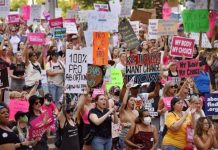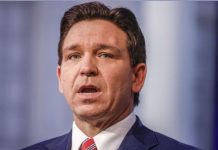
MIAMI, Dec. 20 (UPI) — A Florida community rattled by an increase in brain cancer rates is awaiting state data that could determine whether they’re living in a cancer cluster.
In St. Lucie County, about 80 miles north of Palm Beach, at least 12 people have been diagnosed with glioblastoma, a rare form of brain cancer, over the past three years. All the patients live within a few miles of each other.
Stephanie Ankiel-Cunningham is a tuberculosis nurse whose husband, Mark Cunnigham, was diagnosed with glioblastoma in 2012 at age 28. She said her husband was one of three people diagnosed with brain cancer in the same neighborhood — two on the same street and a third on an adjacent street. She wants the government to conduct tests right away to find the cause.
“This is crucial. People are dying, young people are dying and nobody wants to step in,” Ankiel-Cunningham told UPI. “This is public health. This is what they should be doing.”
If a cluster is determined, state and federal governments would conduct investigations to determine the cause. However, statewide data on cancer diagnoses from 2016 and 2017 have not been released by Florida’s cancer registry, which is run by the University of Miami.
The data was originally scheduled for a November release, but isn’t expected to be public until sometime next year.
In a letter earlier this month, Rep. Brian Mast, R-Fla., asked the agency to “stop delaying the release of their crucial study and expedite its completion before more people are put in harm’s way.”
In a statement, the Florida Department of Health denied that there has been a delay in releasing data from 2016 and 2017 and that researchers are crunching the numbers.
“It is the goal of the department to conduct as thorough an investigation as possible, and no shortcuts will be taken in the data collection or verification process,” said Nick Van Der Linden, the department’s interim communications director. “The health and safety of Floridians is our top priority. Once the analysis is complete, it will be shared with the public.”
Meanwhile, St. Lucie residents are waiting to get the updated information that could shed light on why their loved ones are dying.
County health officials said they are assessing the risks for cancer in the area but have not found any evidence of a cancer cluster based on data before 2016.
“The review has found that the occurrence of glioblastoma cancer in all local areas in St. Lucie County mirrored what is to be expected given the population size and demographics,” officials said in August. “On average, each year there were 10 new glioblastoma cases for the entire St. Lucie County reported to the Florida Cancer Data System during 1996 to 2015. The majority of these cases were reported among adults age 60 or older.”
This isn’t the first time St. Lucie County has been struck with a cancer scare.
Between 1981 and 1997, children in St. Lucie were contracting brain cancer at three times the national average, the South Florida Sun-Sentinel reported at the time.
The Environmental Protection Agency later found carcinogenic volatile organic compounds, known as VOCs, in St. Lucie drinking water, as well as water in several other areas that had spikes in pediatric cancer cases, including Toms River, N.J.; Winona, Texas; and Woburn, Mass.
A few years later in 2010, Florida health officials declared a cancer cluster in The Acreage, located about 65 miles south of St. Lucie County after at least 13 children were diagnosed with brain cancer or brain tumors between 1993 and 2008.
The cause of the cancer cluster is still being disputed by experts and courts. But affected residents filed a class-action lawsuit against aerospace manufacturer Pratt & Whitney for allegedly leaking cancer-causing chemicals into the local drinking water.
That lawsuit is still pending and faces a contentious legal battle as state and federal laws pose obstacles for the plaintiffs, said Mara Hatfield, the attorney handling the case. If The Acreage ordeal is any lesson, St. Lucie residents won’t be able to rely solely on local government sources to find the cause of the cancer spike.
Despite the cancer cluster confirmation in 2010, residents had to obtain information through attorneys and independent investigators who found high levels of radioactivity in areas where people were diagnosed with cancer.
“Not until after various discovery we filed suit for a group of parents at two different time periods after we found radioactive elements in their soil,” Hatfield said, adding that an updated state report after the cancer cluster was declared has never been issued by the state.
St. Lucie resident Christine Yaroch was 69 when she was diagnosed with glioblastoma in August 2017. She died nine months later. Her daughter, Kimberly Hart, is worried that there could be something in the area causing the glioblastoma cases that is continuing to do so because it hasn’t been discovered.
“The biggest thing right now is trying to find what to test for, but the state hasn’t seemed like they’re interested in doing anything,” Hart said.
Ankiel-Cunningham has been working to spread awareness in her community and to get officials to conduct tests in the area, but the mother of two is considering moving her family out of Florida altogether.
In addition to the second brain cancer spike in St. Lucie County and the ongoing situation in The Acreage, Brevard County is being investigated by the Centers for Disease Control and Prevention as a potential cancer cluster and Union County has the highest rate of lung cancer in the country.
However, with questions surrounding Florida’s data, Ankiel-Cunningham questions the accuracy of cancer data in other states.
“Where can you go? It’s everywhere,” she said.






